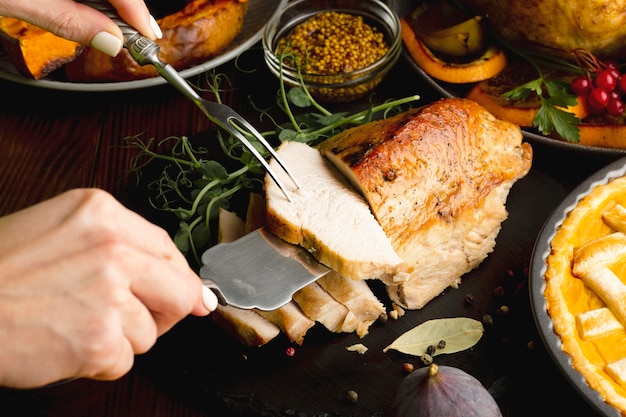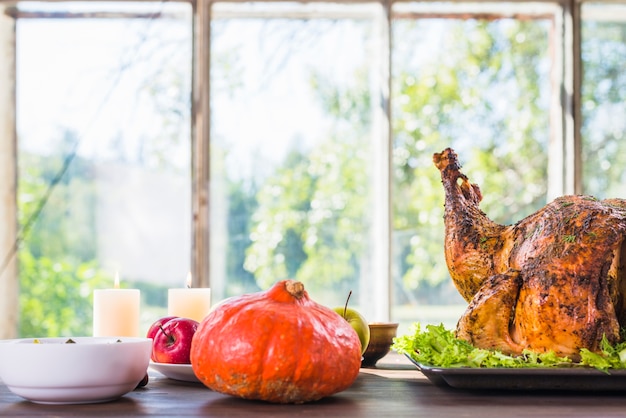(Part 1) Laying the Foundation

Size Matters: The First Rule of Turkey
You've heard the saying "size matters," and it's truer than ever when it comes to roasting a turkey. A small bird will cook much faster than a large one. Think of it like baking a cake: a smaller cake pan will need less time in the oven. The same principle applies here.That's why weighing your turkey is the absolute first step. Grab your kitchen scales and get an accurate reading. If you don't have scales, you can estimate, but a precise measurement is always best.Stuffing: Friend or Foe?
Stuffing adds another layer to the turkey cooking puzzle. It needs to be cooked thoroughly, and it can actually slow down the cooking process. Why? Because stuffing traps heat inside the bird, holding it back from reaching the core temperature quickly.If you're planning to stuff your turkey, you'll need to adjust your cooking time accordingly. I'll explain how to handle stuffing later on, but for now, just remember that it's a factor you need to consider.The Oven: A Vital Partner
Finally, your oven plays a crucial role in roasting success. Most ovens are perfectly capable of handling a turkey, but it's wise to check your owner's manual to make sure yours is up to the task. And remember, preheating your oven to the recommended temperature is essential. You want that oven nice and toasty before you introduce your turkey to the party. The ideal temperature will usually be around 325°F (165°C), which allows for even cooking and a gorgeous golden-brown skin. We'll delve into oven temperatures in more detail later, but for now, make sure to preheat your oven to the right temperature for a flawless roast.(Part 2) Decoding turkey cooking times: The Science Behind the Roast

General Guidelines: A Starting Point
First, let's establish some general guidelines. Remember, these are just starting points, and cooking times can vary based on your oven, the shape of the turkey, and even how stuffed it is. But they give you a good place to start:| turkey weight (lbs) | Cooking Time (hours) |
|---|---|
| 10-12 lbs | 3-3.5 hours |
| 12-14 lbs | 3.5-4 hours |
| 14-16 lbs | 4-4.5 hours |
| 16-18 lbs | 4.5-5 hours |
| 18-20 lbs | 5-5.5 hours |
The Rule of Thumb: A Quick Calculation
Another handy tip is the "rule of thumb": 15 minutes per pound for an unstuffed turkey. That means a 10lb turkey will take roughly 2.5 hours. For a stuffed turkey, add an extra 30 minutes to the total cooking time.This is just a general estimate, but it's a great starting point for calculating your cooking time.The Rest is Key: Time for Relaxation
One of the most important things to remember is to let your turkey rest after it comes out of the oven. Resting allows the juices to redistribute, resulting in incredibly moist and tender meat. I highly recommend letting your turkey rest for at least 20 minutes before carving. Trust me, it's worth the wait!(Part 3) The Stuffing Debate: Inside or Out?

Stuffing the Bird: The Traditional Route
Stuffing the bird is the classic approach, and it can add a delightful aroma to your roasting process. However, it also requires extra vigilance to ensure the stuffing is thoroughly cooked. The stuffing needs to reach a safe internal temperature of 165°F (74°C). If you choose this method, be sure to use a stuffing recipe that's safe for cooking inside a turkey. You want to minimize the risk of undercooked stuffing, which could lead to foodborne illness.And remember to factor in that extra 30 minutes of cooking time for a stuffed turkey.Baking Separately: Safety First
My personal preference is to bake the stuffing separately. It's easier to ensure that the stuffing cooks through properly, and it eliminates the potential worry of undercooked stuffing. You can bake it in a casserole dish, making it easy to check the temperature with a meat thermometer. Cook it until it reaches that crucial 165°F (74°C), and you're good to go. I love to add a few tablespoons of turkey broth to my stuffing before baking. It adds a burst of moisture and flavor, making it incredibly delicious.(Part 4) Temperature: The Golden Standard for a perfect roast
While cooking time is crucial, temperature is just as important. A meat thermometer is your best friend when it comes to ensuring your turkey is cooked to perfection.The Safe Zone: Target Temperatures
The turkey is considered safely cooked when the internal temperature reaches 165°F (74°C) at the thickest part of the thigh. Make sure to insert the thermometer into the thickest part of the thigh, avoiding any bones. It's a good idea to check the temperature in a few different spots to be extra sure.Overcooking: The Enemy of juicy turkey
One of the biggest mistakes people make is overcooking the turkey. This can lead to dry, tough meat that nobody wants. Keep a close eye on the temperature and take the turkey out of the oven once it reaches 165°F (74°C).White Meat Watch: A Separate Check
The breast meat cooks faster than the thighs, so you might want to check the temperature of the breast as well. The breast should reach 160°F (71°C) for optimal tenderness. However, remember, the thickest part of the thigh is the determining factor for the overall doneness of the turkey.(Part 5) Moisture Matters: The Key to a Tender, Flavorful Turkey
Nobody wants a dry, flavorless turkey. The key to a moist, flavorful bird lies in using the right techniques. Here are a few tips that have become my go-to secrets:Brining: The Ultimate Moisture Boost
Brining is a game-changer when it comes to turkey roasting. It involves soaking the turkey in a salty solution for a few hours, which helps to keep the meat incredibly juicy and tender. You can use a simple brining solution of salt and water, or get more creative with herbs and spices. I've used brining for years, and it makes a world of difference. The turkey comes out incredibly moist and flavorful. It's a little extra effort, but totally worth it.Butter It Up: A Flavorful Touch
Another trick is to butter up the turkey before roasting. You can use a simple butter-based rub or get creative with herbs and spices. Just remember to rub it all over the skin, especially under the wings and legs. It helps keep the skin moist and gives it a beautiful golden-brown color.Basting: The Secret to Juicy Meat
Basting is another excellent way to keep the turkey moist. It's the process of pouring juices or drippings over the turkey while it's roasting. You can use melted butter, broth, or even a combination of both. I usually baste my turkey every 30 minutes, but you can do it more or less frequently based on your preference. It's a matter of personal taste.(Part 6) turkey skin: The Art of Achieving a Golden-Brown Crisp
We've talked about the meat, but let's not forget about the turkey skin. You want it to be crispy and golden brown, right? Here's how to achieve that perfect skin:Dry it Out: The Foundation for crispy skin
Pat the turkey skin dry before roasting. This helps to create a crisp, golden-brown skin. If the skin is damp, it will steam instead of browning properly. Use paper towels to pat the skin thoroughly.Get It High: Elevated Roasting for Crispy Results
If you're aiming for crispy skin, try roasting the turkey on a high rack in the oven. This allows air to circulate around the bird, helping it to brown nicely.The Flip Trick: For Even Browning
Here's a little trick I learned from my grandmother: flip the turkey halfway through cooking. This helps ensure that the bottom gets nice and crispy. Just make sure the turkey is well-supported on the rack so it doesn't topple over.(Part 7) The Final Countdown: Nearing the Finish Line
You're almost there! The turkey is in the oven, and the kitchen is filled with the irresistible aroma of roasted turkey. But before you start daydreaming about gravy, a few things are worth keeping in mind:Temperature Check: A Consistent Monitoring
Check the internal temperature of the turkey every hour or so to ensure it's cooking evenly. You want to confirm that it's reaching that safe temperature of 165°F (74°C) in the thickest part of the thigh.Peek Inside: Visual Inspection for Browning
You can also peek inside the oven to see how the turkey is browning. If the skin is getting too dark, you can tent the turkey with some foil to prevent it from burning. But remember, you want that skin to be nice and golden!Resting Time: The Final Touch for Tenderness
Once the turkey is cooked, take it out of the oven and let it rest for at least 20 minutes before carving. This allows the juices to redistribute, making the meat even more tender and juicy.(Part 8) FAQs: Your Turkey-Roasting Queries Answered
I've been answering your turkey-related questions for years, so I've compiled some of the most common ones here for your convenience.1. Can I cook a turkey on a low temperature?
You can, but it will take longer. It's not recommended because you can end up with a dry bird. If you're roasting a smaller turkey, you might get away with it, but for a larger turkey, it's better to stick to a higher temperature for better browning and faster cooking.2. How do I know if my turkey is done?
Use a meat thermometer! Insert it into the thickest part of the thigh, avoiding any bones. The temperature should reach 165°F (74°C). The breasts should reach 160°F (71°C) for optimal tenderness.3. How do I deal with a frozen turkey?
Thawing a turkey takes time, so plan ahead! The safest way is to thaw it in the refrigerator for 24 hours per 5 pounds of turkey. It’s best to avoid thawing a turkey at room temperature, as this can lead to bacterial growth.4. Can I roast a turkey with the stuffing in it?
You can, but it's not recommended. It can be difficult to make sure the stuffing is cooked through to a safe temperature. It's safer to bake the stuffing separately.5. What if my turkey is overcooked?
If your turkey is overcooked, there’s not much you can do, but try to salvage the situation by carving the meat from the bone. You can always use the dried turkey in a soup or stew.(Part 9) The Final Word: Embrace the Art of Turkey Roasting
Roasting a turkey is a bit of an art form. It takes practice and a little bit of patience, but it's incredibly rewarding to see that beautiful, golden-brown bird come out of the oven. Remember to follow these tips and tricks, and don't be afraid to experiment! Happy roasting, and enjoy your turkey feast!Everyone is watching

Corn on the Cob: The Ultimate Guide to Perfectly Cooked Ears
Healthy MealsAh, corn on the cob. Just the name evokes images of sunny days, barbecues, and that sweet, juicy flavour that ...

Perfect Pork Roast Oven Cooking Time: A Guide to Delicious Results
Healthy MealsThere's something truly satisfying about a perfectly roasted pork. The aroma alone is enough to make your mout...

Ham Cooking Time: How Long to Bake, Smoke, or Boil a Delicious Ham
Healthy MealsAh, ham. It's a classic, isn't it? A real crowd-pleaser, especially around holidays. And when done right, it'...

Scallops: The Ultimate Guide to Perfect Cooking
Healthy MealsAh, scallops. Those delicate, sweet, and utterly delicious morsels of the sea. They hold a special place in my...

Spaghetti Squash: The Ultimate Guide to Cooking and Serving
Healthy MealsRemember that time you saw spaghetti squash at the supermarket, looking all bumpy and strange, and thought, "W...
